Good Looking, Tough And Easy To Carry. The lionSteel T5 is The Knife We All Aspire To Be
The lionSteel T5 is a good looking knife. It is also relatively expensive. This is a combination that often gets me in trouble when writing a review. It is just too easy to make excuses for a knife’s shortcomings if I like the way it looks or had to turn tricks at a truck stop for a month to afford it.
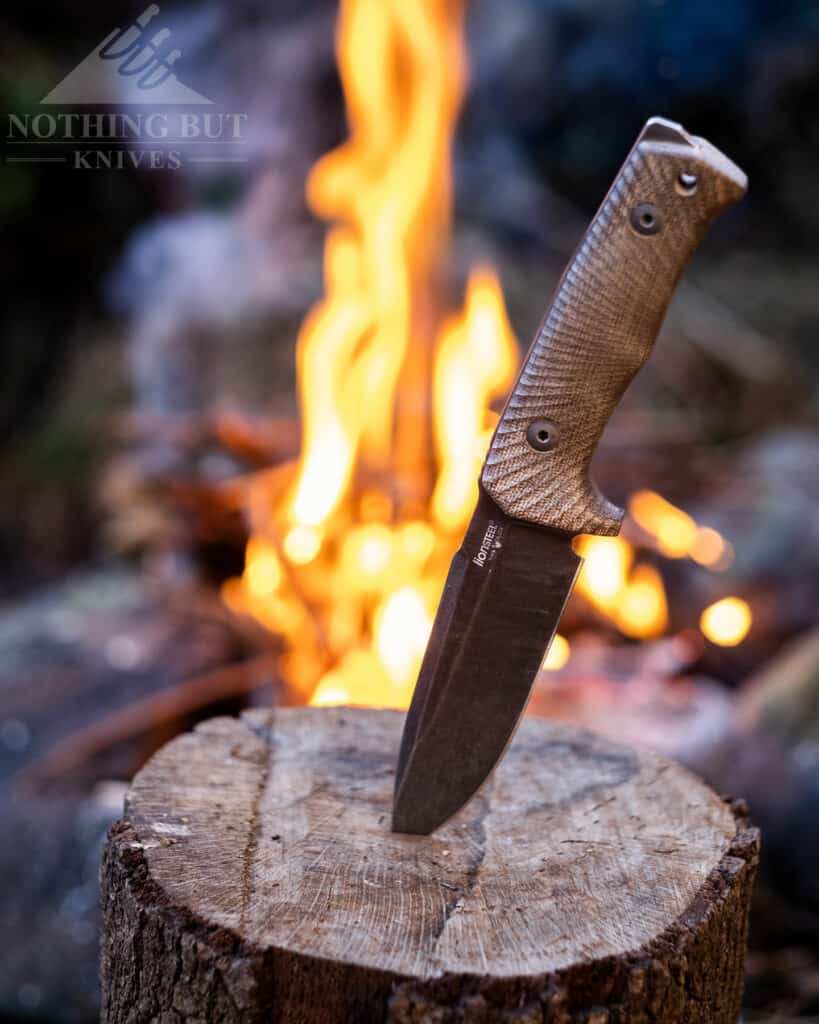
This is the part of the review where I would normally make an analogy about relationships being like knives and say something like “It’s easy to makes excuses for a significant other who is expensive or good looking”, but I am not gonna not do that in case my wife ever finds out about this site. (Editor’s Note: Imagine finding out about this site and the truck stop on the same day.)
Due to the fact that I was skeptical about my ability to be objective about the T5, I spent more time than I normally do testing it out. I straight up abused this knife for months before I wrote one word about it. For the most part I was impressed. LionSteel calls the T5 a tactical knife in their product description, but the design makes it pretty obvious that lionSteel intends this knife to be a tactical/survival knife hybrid.
The T5 handled a variety of survival and bushcraft tasks fairly well. I did manage to chip the blade a bit batoning through a tough oak log full of knots, but that log would have chipped most dedicated bushcraft knives so I didn’t hold that against the T5.
Specifications
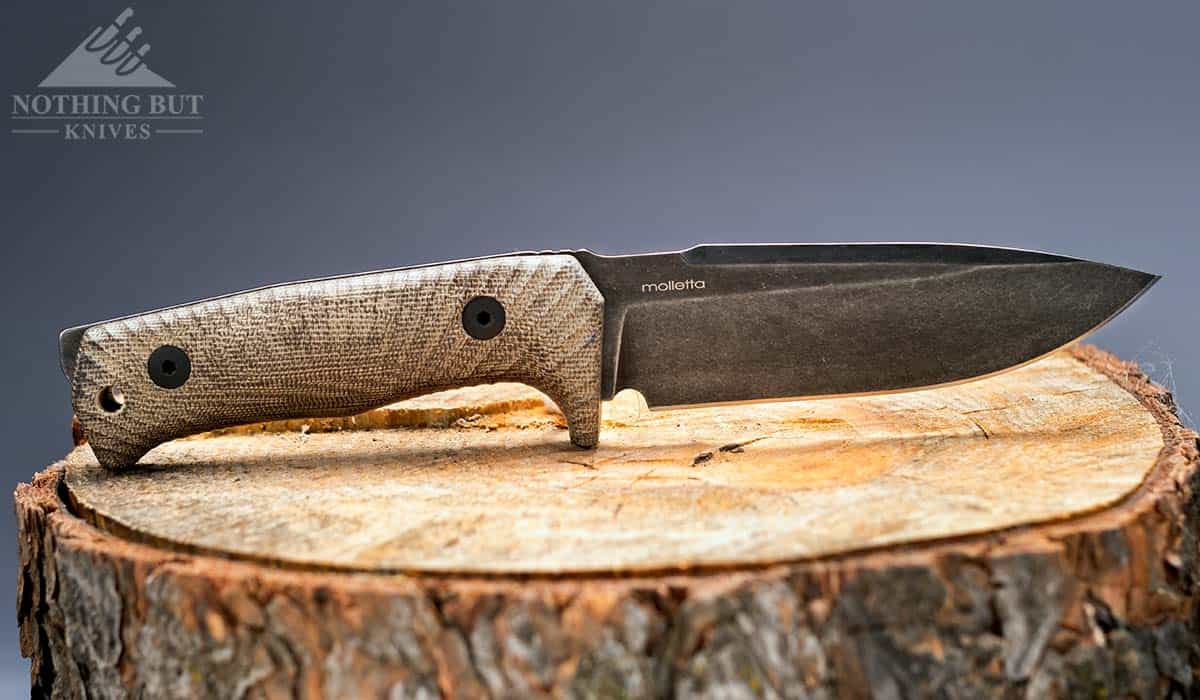
| Overall Length: | 9.92″ |
| Blade Length: | 5.04″ |
| Handle Length: | 4.88″ |
| Blade Steel: | Niolox |
| Blade Grind: | Flat |
| Blade Thickness: | 5 mm |
| Blade Style: | Drop point |
| Handle Material: | Micarta |
| Knife Weight: | 9.39 oz |
| Weight w/ Sheath: | 13.8 oz |
| Sheath: | Leather |
| Made in: | Italy |
| Price Range: | $157 – 199 |
| Designer: | Michele Pensato (Molleta) |
Pros
| Versatile sheath |
| Practical blade design |
| Great balance |
| Ergonomic handle |
| Easy to sharpen |
Cons
| Lanyard hole does not go through the tang |
| Butt cap causes a hot spot when chopping |
| Only offered with a right handed sheath |
The Blade
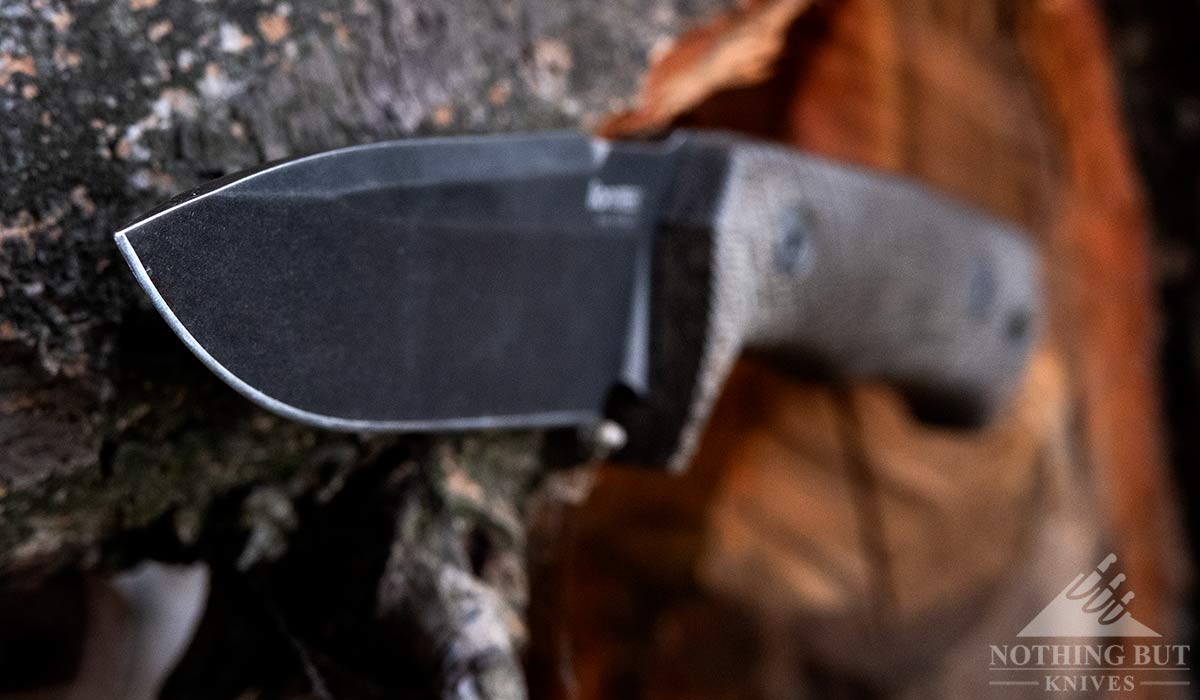
The T5 blade is a thing of beauty. It has the lines of an Italian sports car, but it does not sacrifice function for the sake of aesthetics. The spine of the blade is 5mm which seems to be the standard thickness these days for fixed knives that are designed for survival tasks. The blade sports a high flat grind which is further evidence that the T5 was designed for versatility rather than a one trick tactical pony.
The blade swedge looks great, and it increases the knife’s piercing capability. Fortunately the swedge does not continue to the handle, but morphs smoothly into a well placed thumb rest. This is nice for those of us that like to use the Filipino grip for detail work.
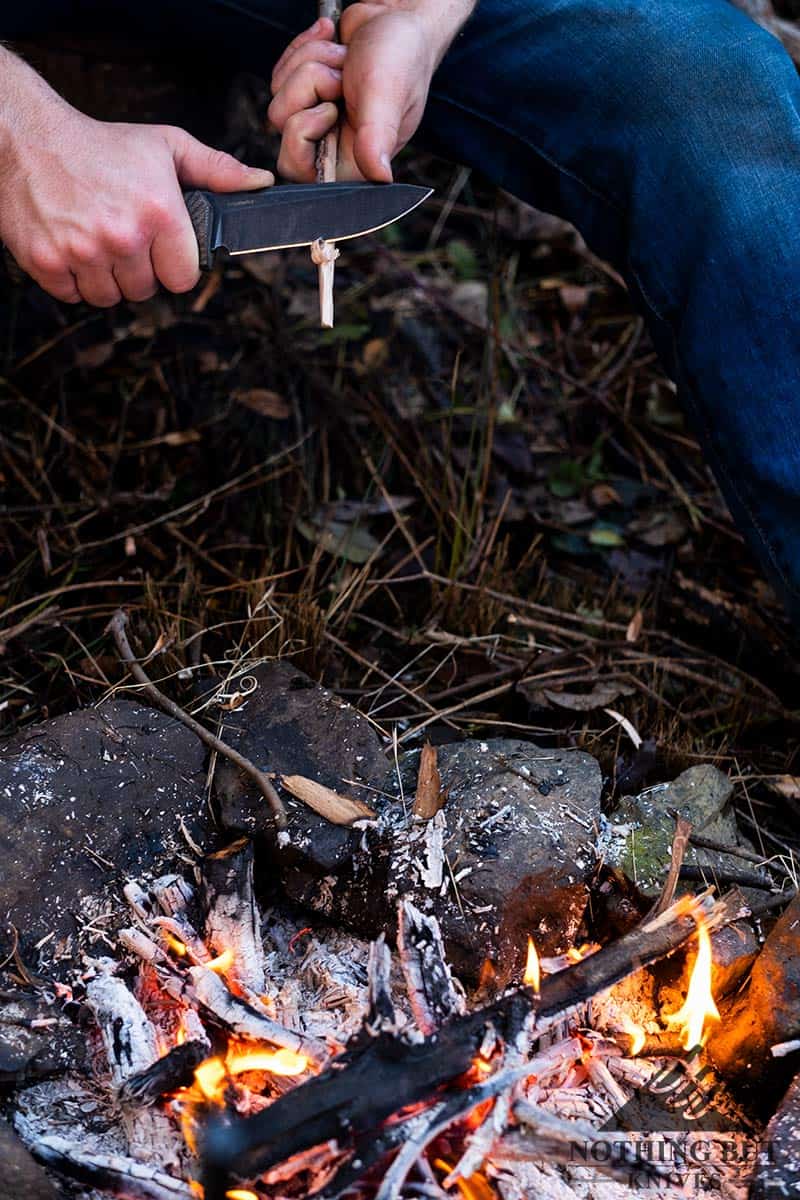
The drop point blade has a tip that is North of center which helps make it a decent option as a hunting knife. The T5 still would not be my first choice for a hunting knife, but it would get the job done.
The sharpening choil is pretty large which is nice for anyone who regularly sharpens knives in the field. It also creates a of of spark on a ferro rod for making a fire. I will talk more about that in the “field testing” section of this review.
Lionsteel chose to make the blade from the increasingly popular Niolox steel. Niolox is very similar to D2 steel, but it’s easier to sharpen, and more corrosion resistant. It also holds a slightly better edge depending on the heat treatment. I found the edge retention of the T5 to be really similar to the Off-Grid Alpha Dog which has a D2 steel blade with excellent heat treatment. However, the Niolox steel blade of the T5 is quite a bit easier to sharpen than any of my D2 steel knives.
I was really shocked by how easy it was to debur. This is a nice feature to have on a knife that I will be sharpening by fire light in the mountains on a semi-regular basis. (Editor’s Note: In this case “semi-regular” means whenever one of us accidentally hits it on a rock, so roughly once a week.)
Overall the T5 blade is a nice compromise between durability and slicing performance. Lionsteel has stated that they received a lot of input from soldiers prior to designing and manufacturing this knife, and it shows when using the T5 for a variety of outdoor tasks.
The Handle
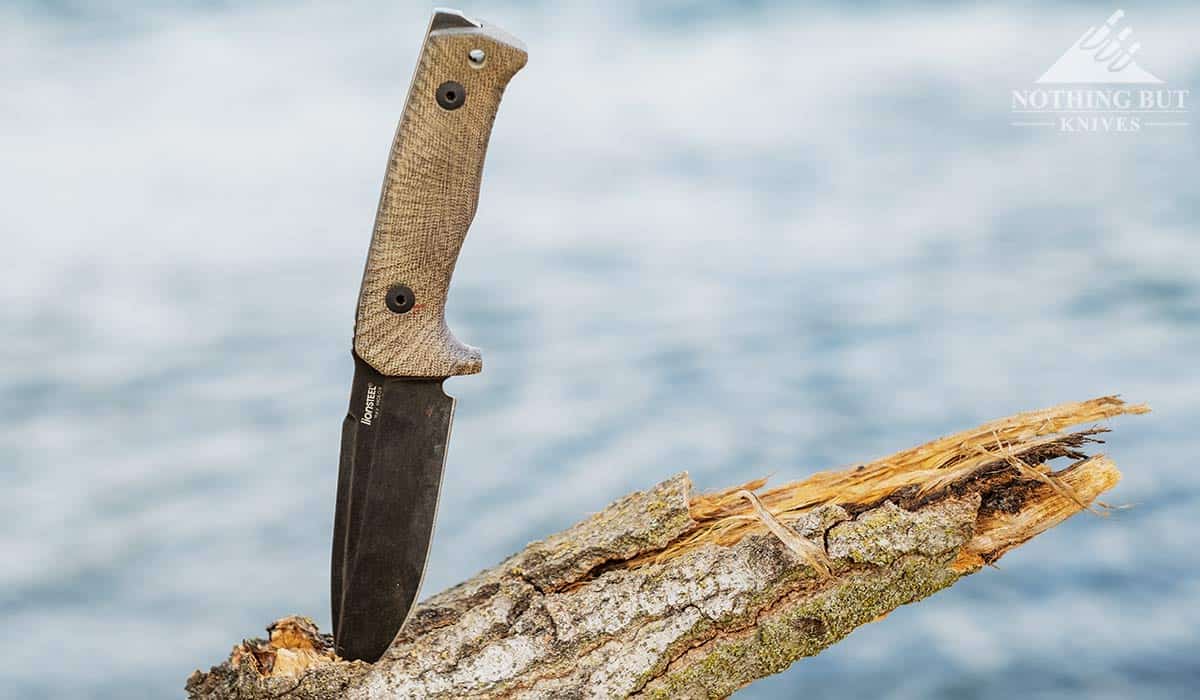
The handle of the T5 is what first drew me to this knife. It is made of a single piece of Micarta. Most fixed blade knives with Micarta handles have two slabs of Micarta (called scales) screwed to the handle of the knife. For the T5, lionSteel has milled the handle out of a single piece of Micarta that wraps under the knife tang.
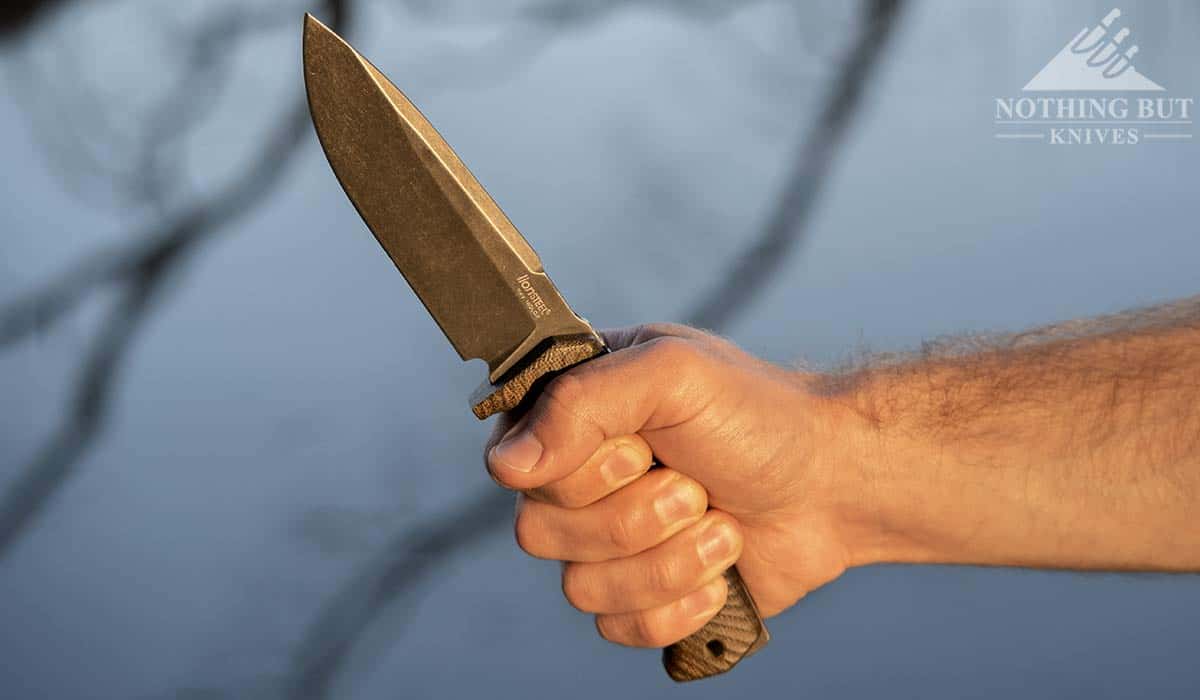
The contour of the handle fills the hand nicely without bulging too much. The texture of the handle provides decent grip, but I initially found the handle to be slicker than it looked. However, the more I used it the grippier the handle became. Once it was stained with a gross combination of dirt and hand sweat the handle seemed quite a bit easier to grip than when it was shiny and new.
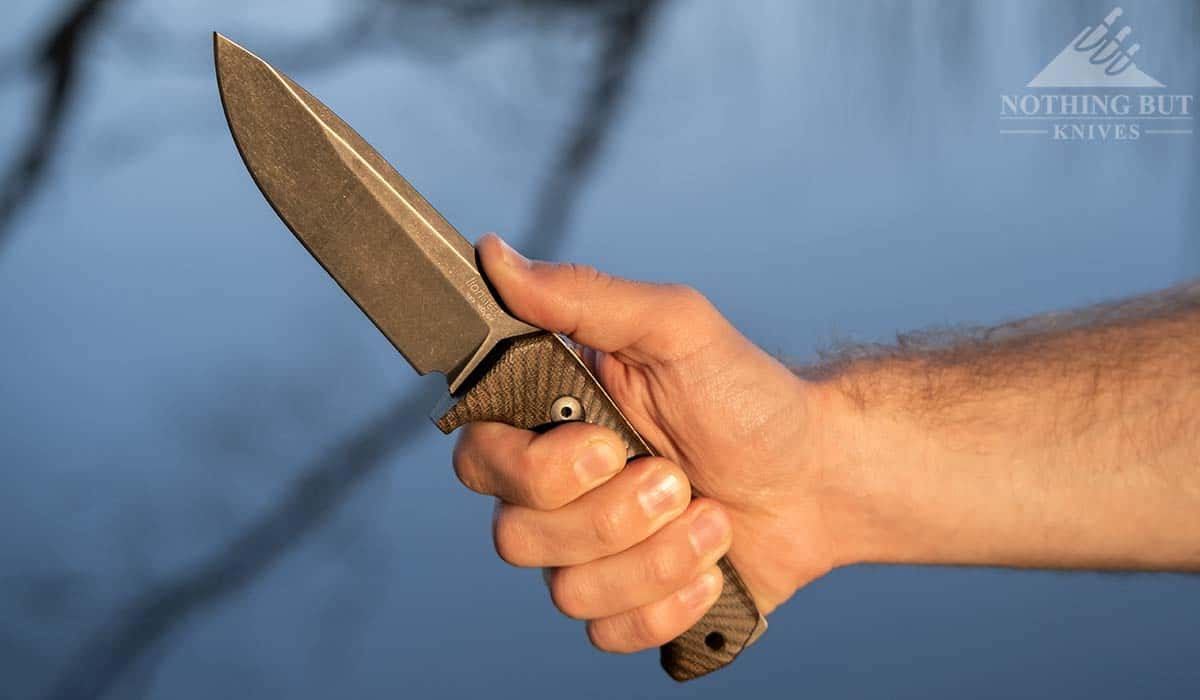
As I mentioned before, the thumb rest on the back of the blade spine is comfortable, but I do wish it was a little longer and that the swedge was a bit shorter so I could fit more thumb real estate on it without feeling cramped. But that’s a small issue.
I do have two larger complaints about about the T5 handle, though. The first is that the lanyard hole only passes through the Micarta section of the handle. It does not pass through the actual steel tang. This is unfortunate because I would never trust that lanyard hole with a wrist attachment for chopping.
My second complaint about the handle is that the butt plate sticking out of the back of the handle tends to dig into the bottom of the palm of my hand when I am chopping. I personally would prefer that the Micarta covered the back of the tang, but I know there are some who prefer a knife with a butt plate.
The Sheath
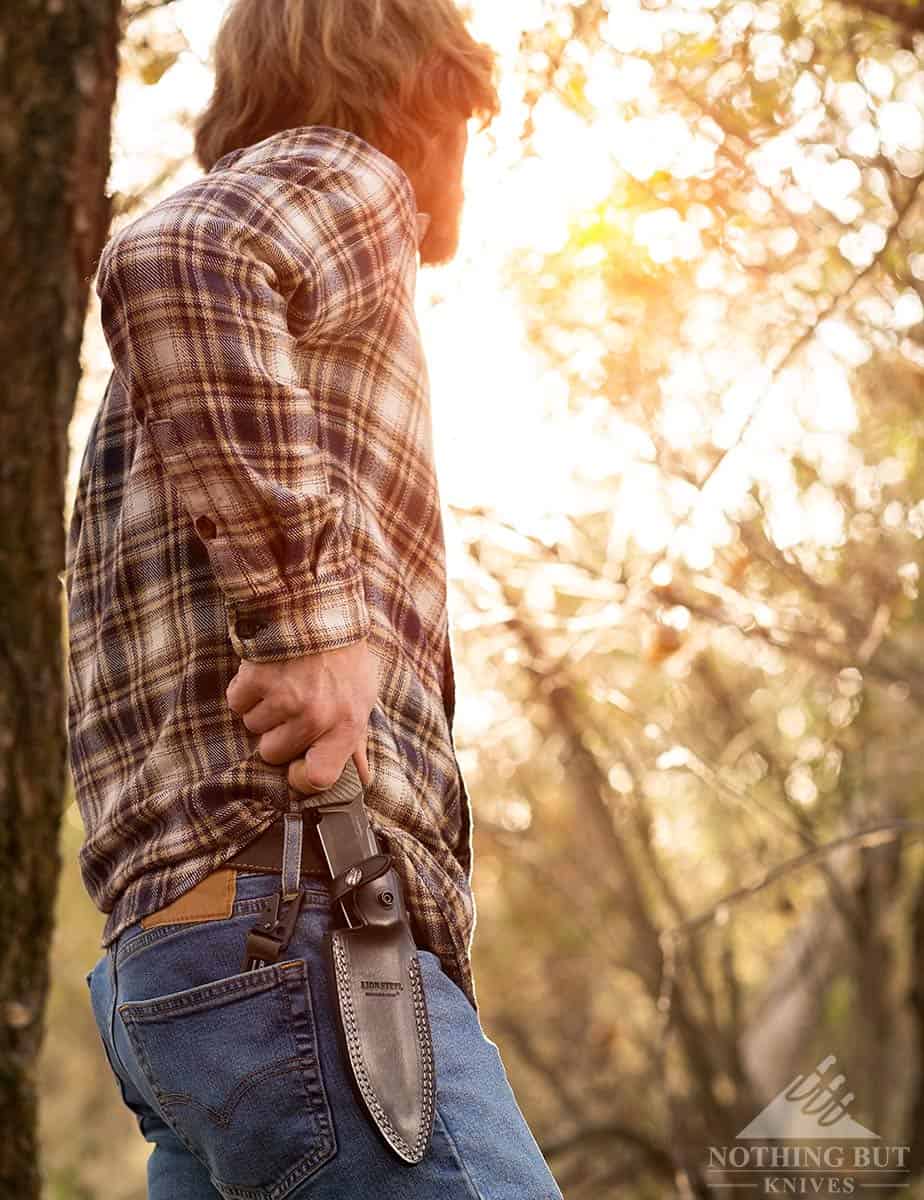
As long as you are right handed the heavy-duty leather sheath is awesome. The sheath is made of thick black leather held together with double stitched thread. It feels incredibly durable, and it helps justify the relatively high price tag of the T5. Hopefully lionsteel will come out with a left handed version at some point.
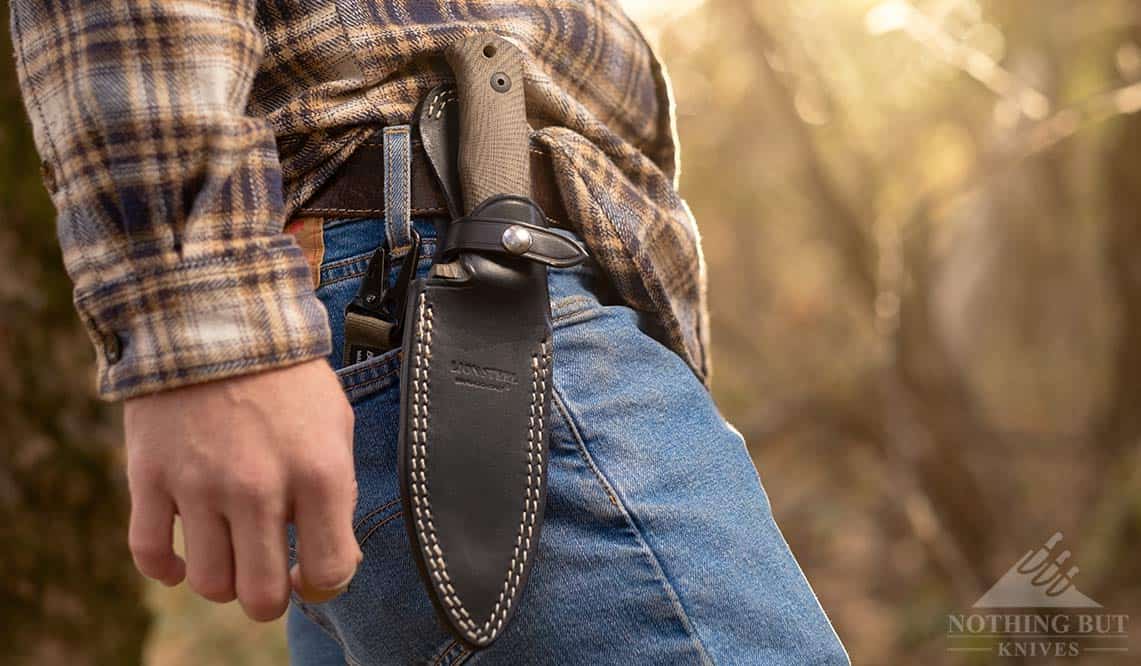
The T5 sheath sits low on the hip which makes it easy to draw the knife quickly without twisting your hand at an awkward angle. When worn in the cross draw position I felt like the sheath sat a little too low to be easily drawn, but results may vary by body type. (Editor’s Note: Be advised that we are a short people.)
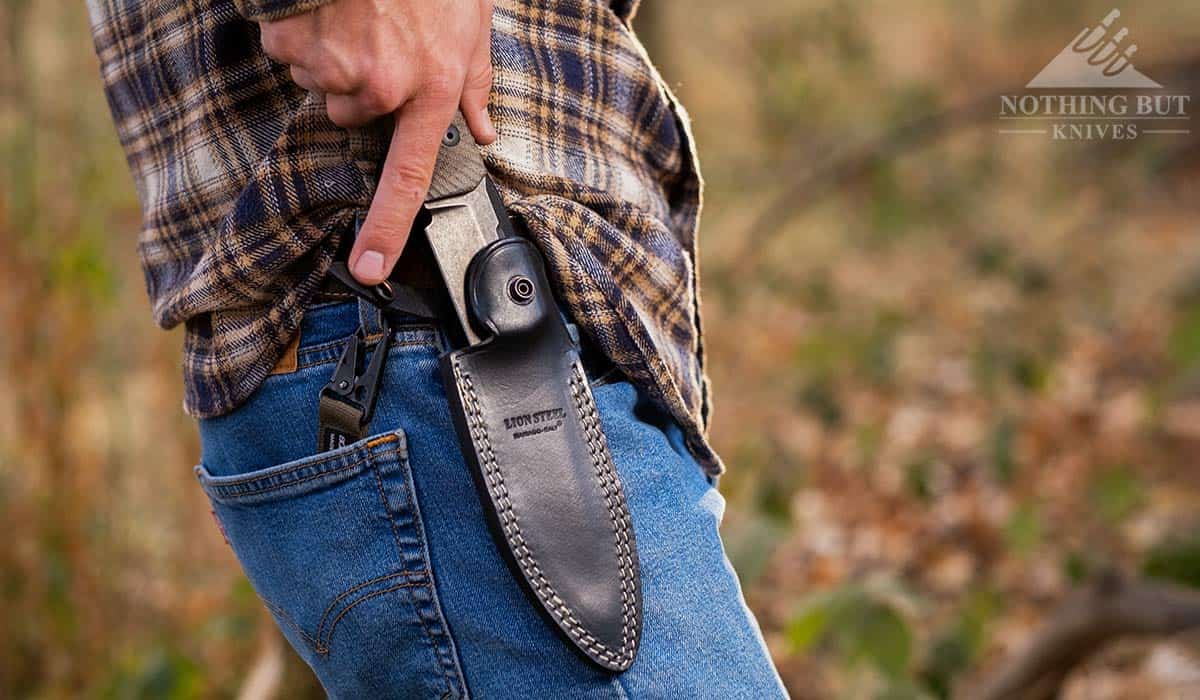
The first few times I drew the knife and replaced it in its sheath, I pushed the restraining strap back with my index finger out of habit, because those straps tends to catch on the blade guard of a lot of other fixed blade knives. However, the sheath overwrap is so well designed that it makes it possible to easily draw and resheath the T5 without pushing the retaining strap back with the index finger. It also does a great job of holding the knife in place even if the knife is upside down on a backpack.
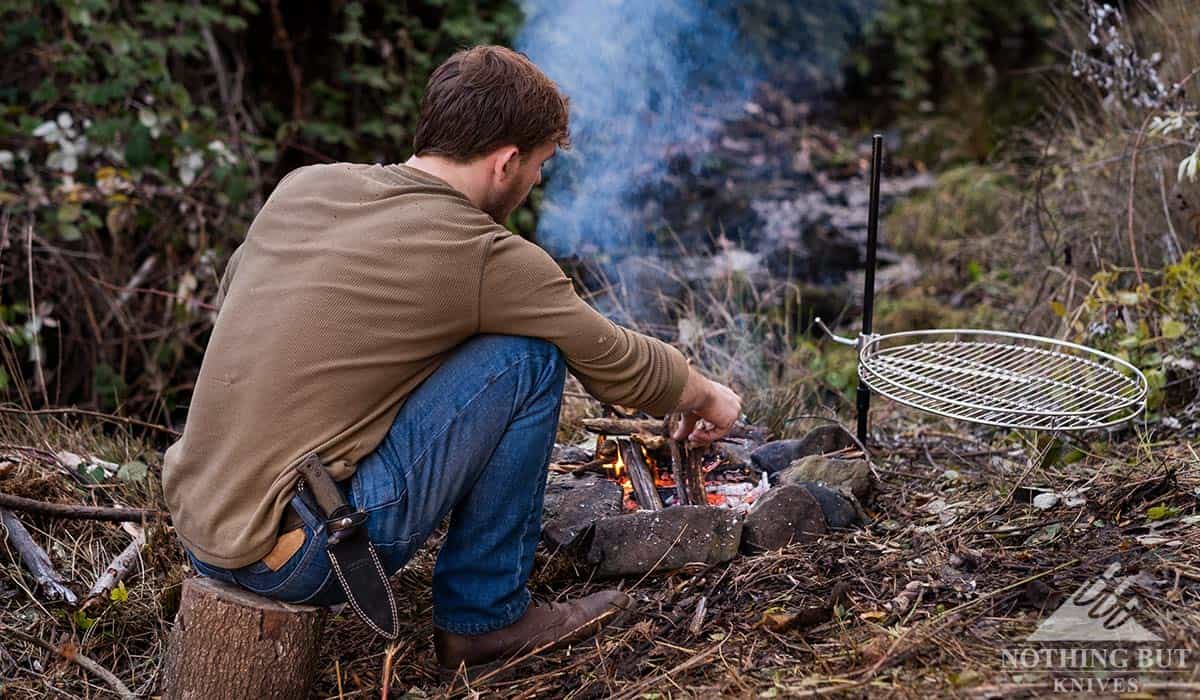
The T5 sheath is easy enough to slide around to get it out of the way on most belts if needed when squatting or sitting. I found the T5 to be a comfortable carry in most camping or backpacking situations, and the sheath is so well made that it can handle catching on underbrush or bumping into a tree without ripping or separating the stitching.
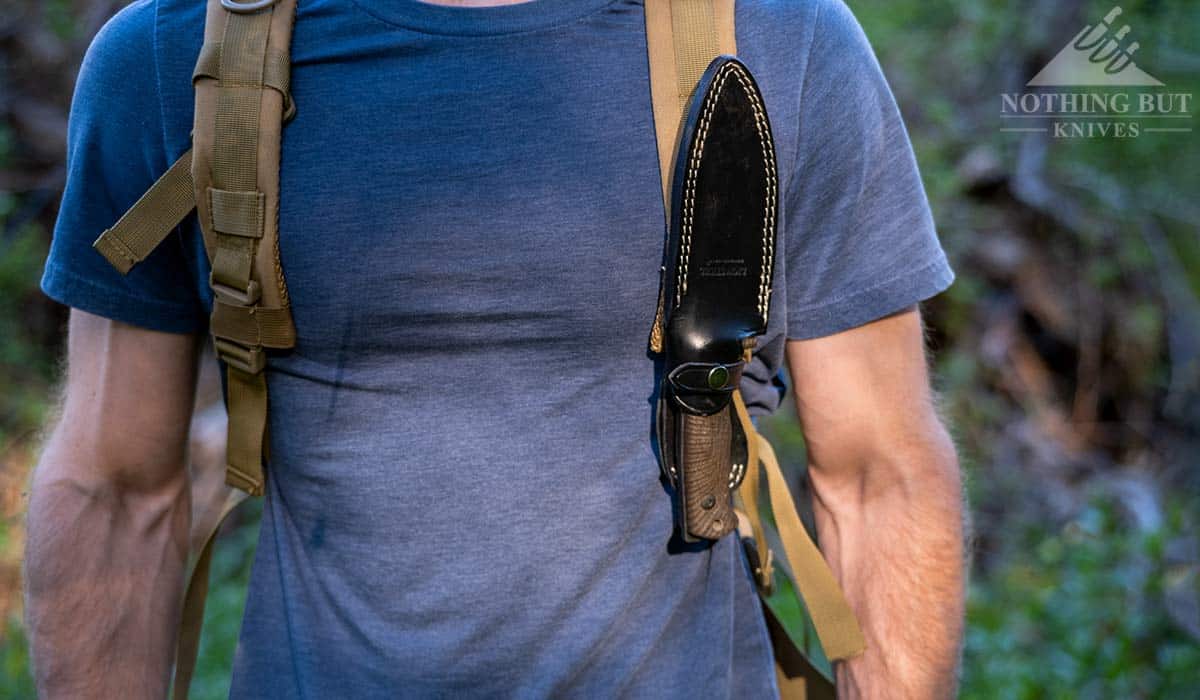
The MOLLE strap on the back of the T5 sheath is a little stiff and difficult to work with when the knife is new, but after trying it out on a variety of backpacks, a vest, and a fanny pack over the course of a few weeks it became easier to work with. The snap can be a little hard to get through tight webbing, but I have yet to find a MOLLE pack I couldn’t attach the T5 to.
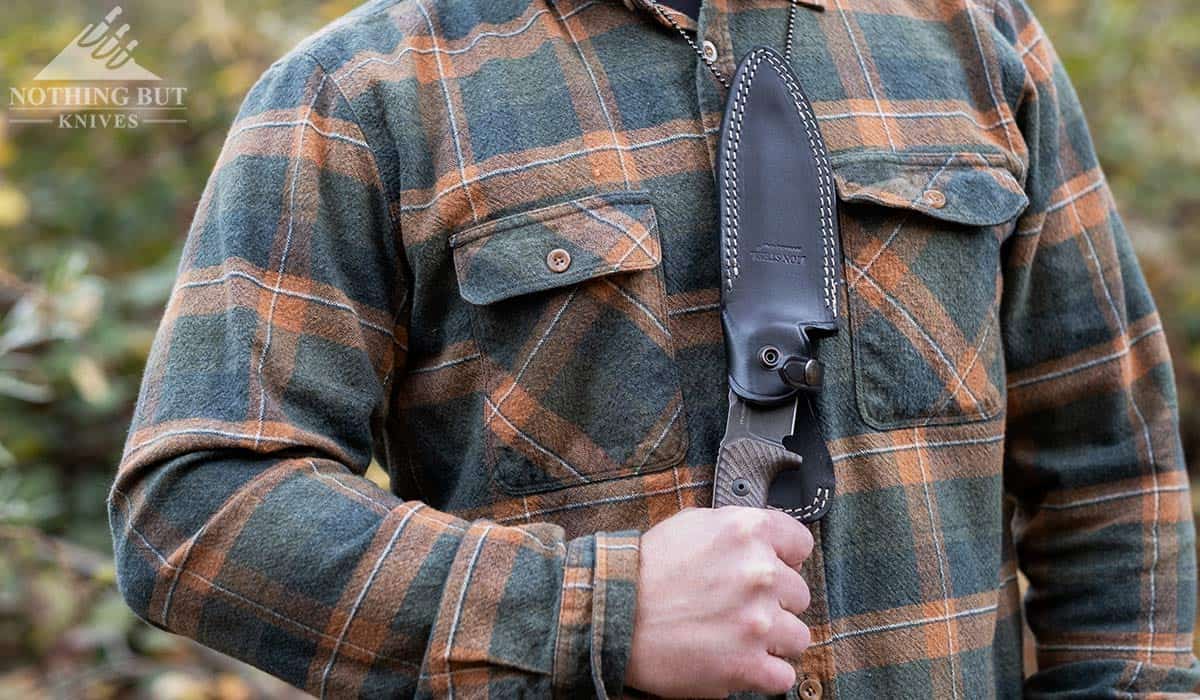
Very few companies make MOLLE compatible leather sheaths. This is unfortunate, because it really does open up a lot of fun and practical carry possibilities. Carrying the T5 as a neck knife is not practical, but it’s nice to have the option even if it is ridiculous.
Field Testing
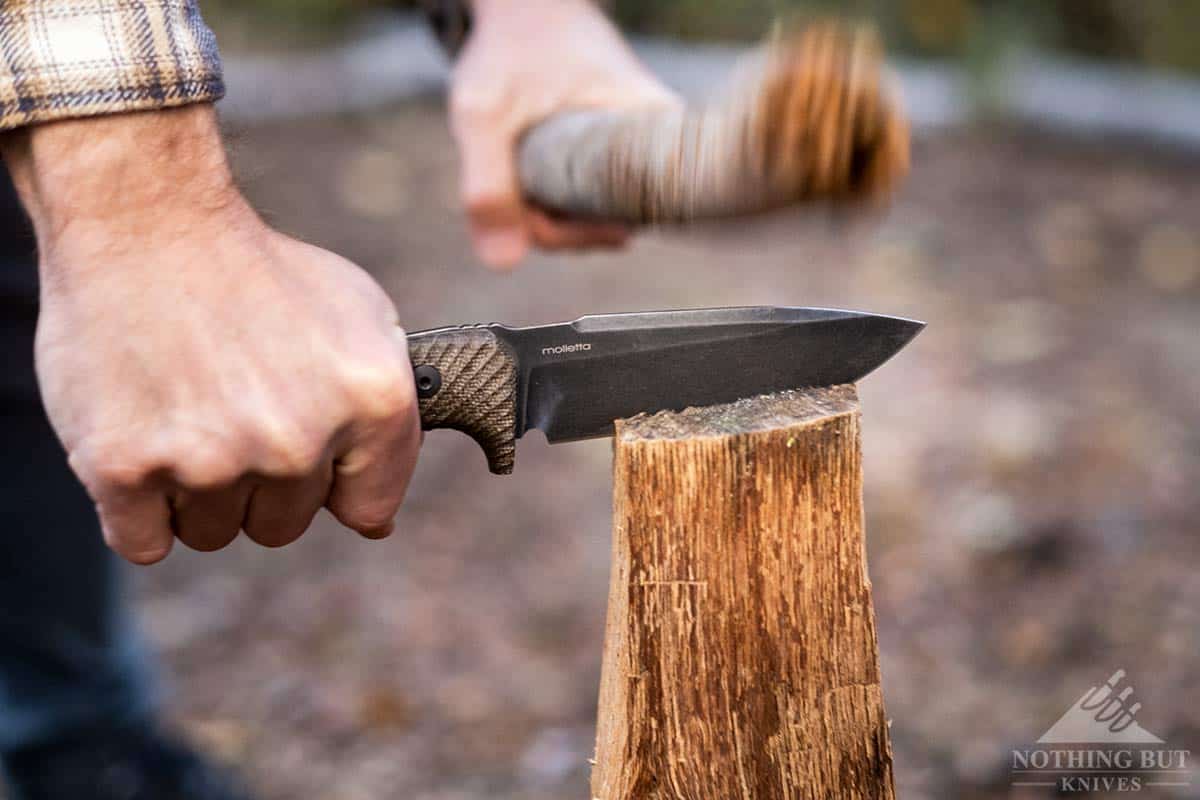
I found the T5 to be surprisingly capable at bushcraft knife tasks even though I consider this knife to be more of a survival knife. I usually lower my expectations of knives that are designed to be tactical-type hybrids. As I mentioned earlier I pushed this knife pretty hard in order to find its limitations and did eventually chip the blade, but this is not something that will happen to the average knife user.
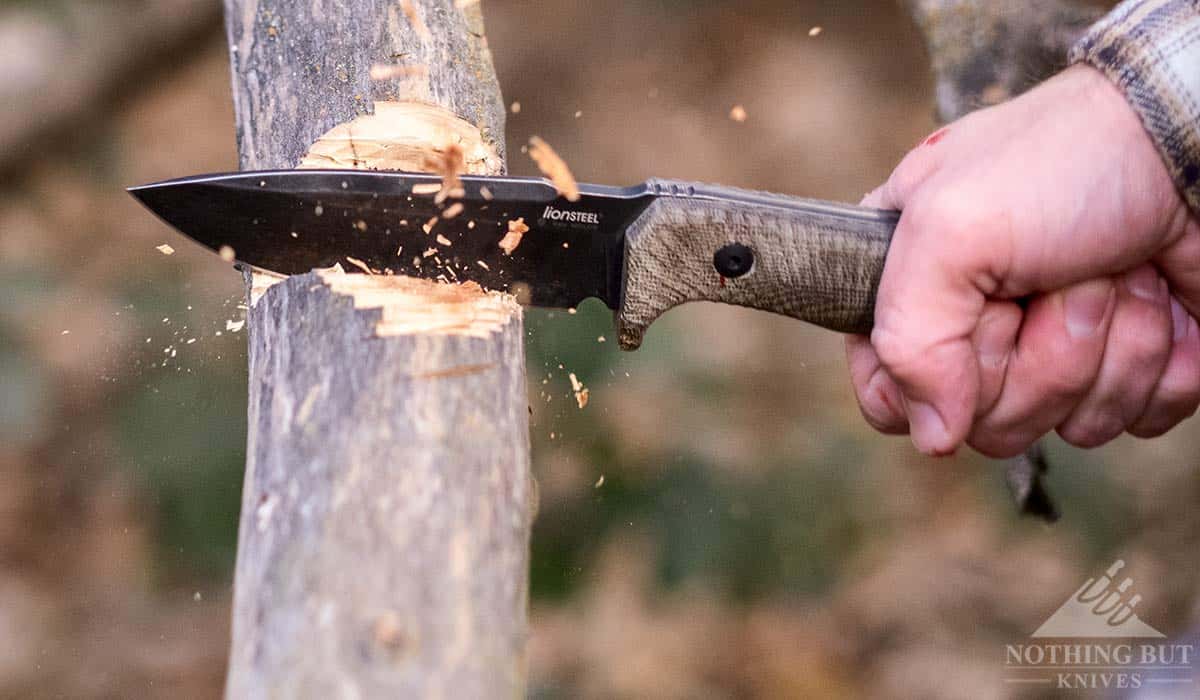
We chopped all kinds of wood with the T5. We chopped hard wood, soft wood, big logs and small logs. The T5 proved to be more than capable. It was not as efficient a chopper as a few of my dedicated bushcraft knives like the Of-Grid Tracker-X and the Condor Stratos, but the blade bit well and chopped faster than I expected it to.
I was also impressed with the toughness of the Niolox steel of the T5. LionSteel heat treated the blade to a Rockwell Hardness of 59. This is a little lower than most Niolox steel blades, and I think it was a good choice. This makes the blade less likely to chip. It comes at the expense of blade retention, but that is usually the preference of people like myself who are pretty hard on knives.
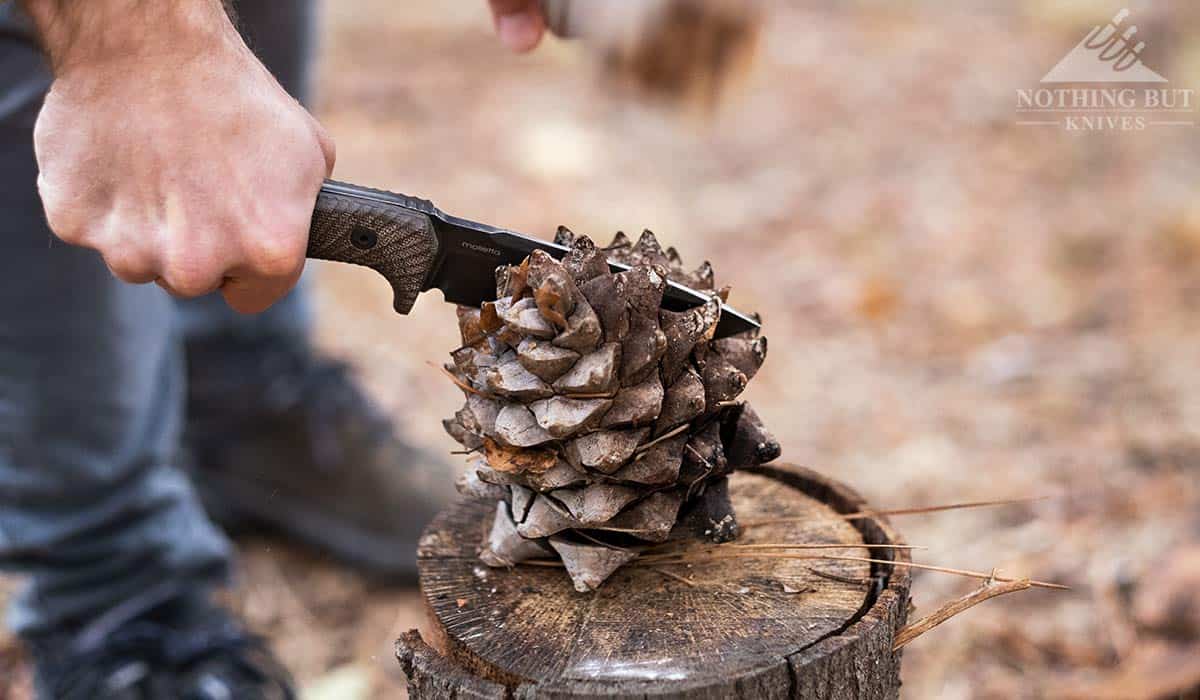
After making short work of a few logs I decided to see how the T5 handled a pine cone. It blew right through it with a few whacks from a batoning stick. So it you are looking for a knife that is super good at chopping through pinecones, the T5 may be a good option.
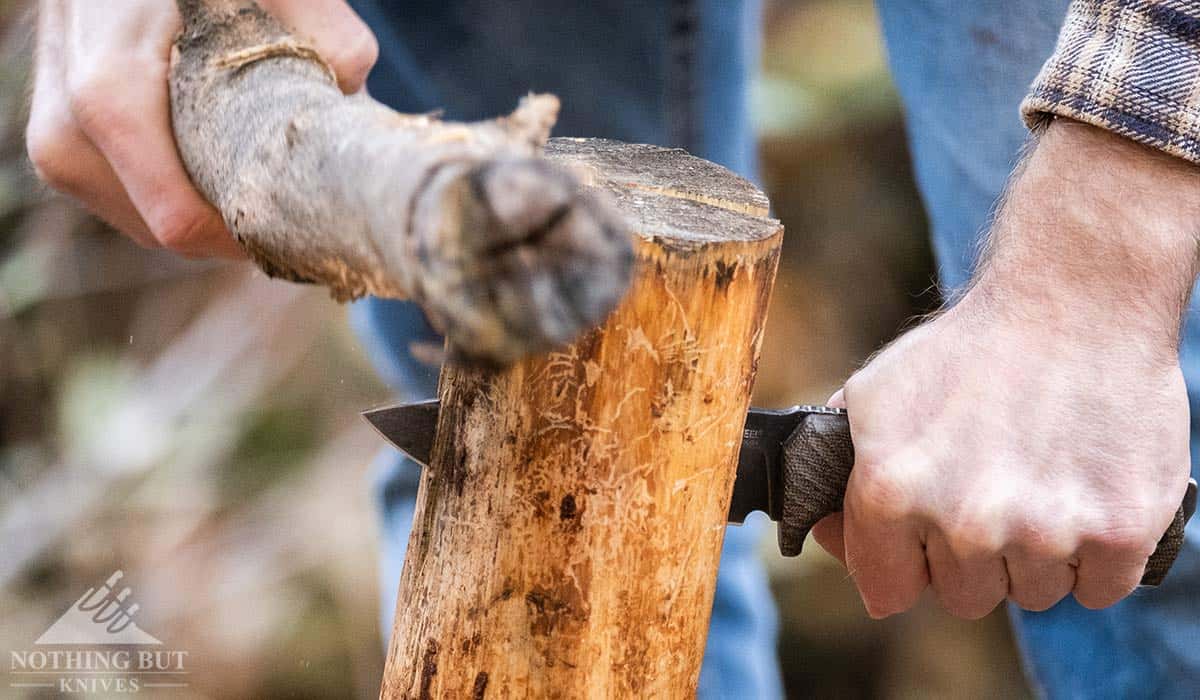
In spite of its tactical aspirations, the T5 blade tapers abruptly at the tip. This makes it less likely that blade tip will break when batoning. We started off easy with the batoning portion of our tests by cutting through the piece of soft pine pictured above. After that we started in on oak logs.
That’s where things got interesting. It handled regular oak logs OK, although it didn’t exactly melt through them like a lightsaber. However, when we tried batoning through a hard piece of oak with several large knots the T5 got wedged. We backed off and then hammered through. This resulted in a piece of oak that was split and a knife that was chipped.
The chips were small, and I think that log would have chipped or rolled most knives, but we did find the limits of the T5’s bushcraft capabilities.
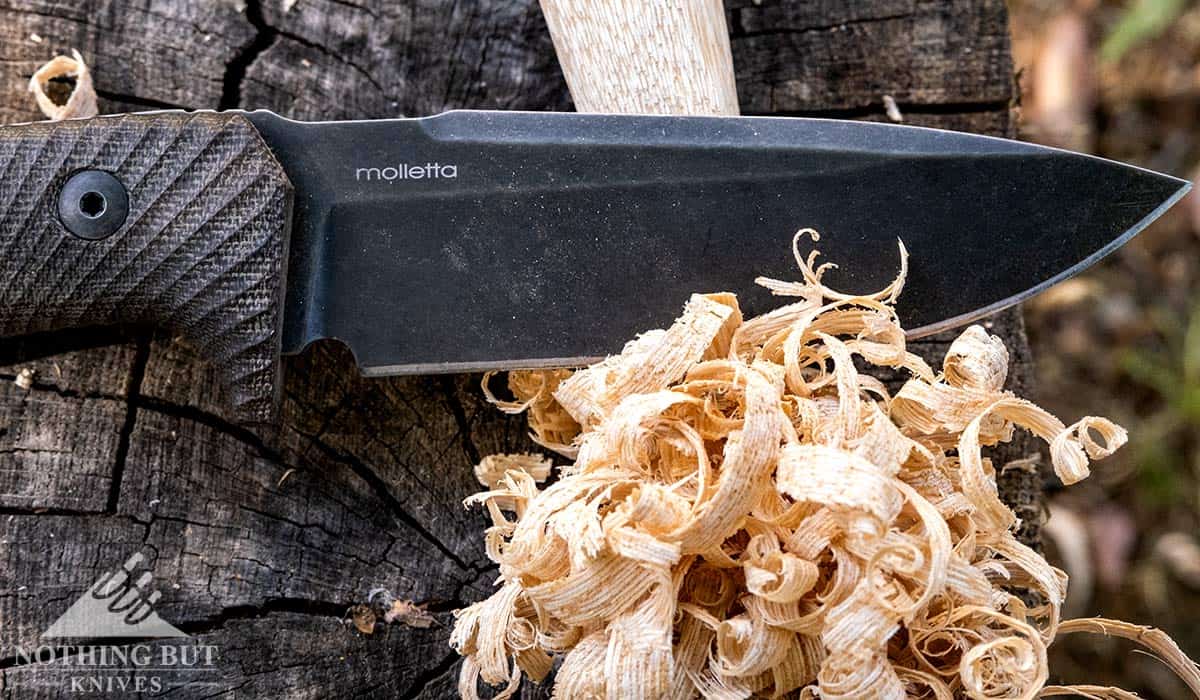
The T5 is a feather sticking machine. The high flat grind and tall edge are part of what make the T5 create pretty curls fairly effortlessly. The handle shape seemed perfect for feather sticking, and I was impressed with the lack of aches and pains I often experience in my hand when feather sticking with other knives.
When the handle is held in a hammer grip directly behind the blade guard it really is quite comfortable.
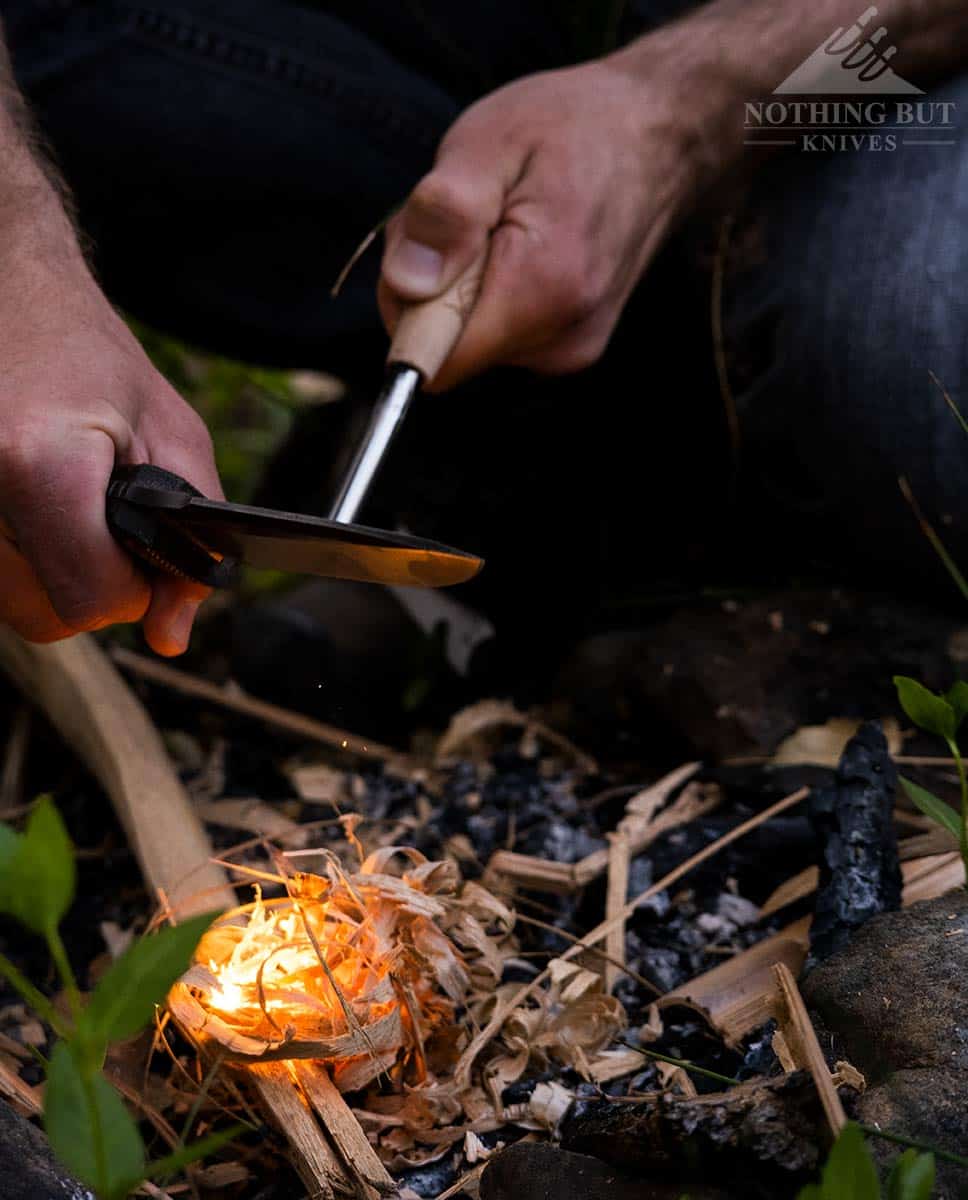
There is no part of the spine of the lionSteel T5 that has a 90 degree angle. All the edges are rounded. As a result the spine of this knife is completely worthless when it comes to throwing spark with a ferro rod.
Fortunately the large sharpening choil at the base of the blade can create more than enough spark to start a fire with a ferro rod. Thinner rods work better. It is possible to create decent spark with a ferro rod that is 3/8 inches in diameter, but a thinner rod is more effective with the T5.
The ideal ferro rod for the T5 is 5/16″ (7.9mm) or less in diameter so that the whole thing actually fits inside the choil. Otherwise you’re basically scraping with just the top corner, and it gets easier to accidentally slip with the rod and end up using the sharpened edge to throw spark.
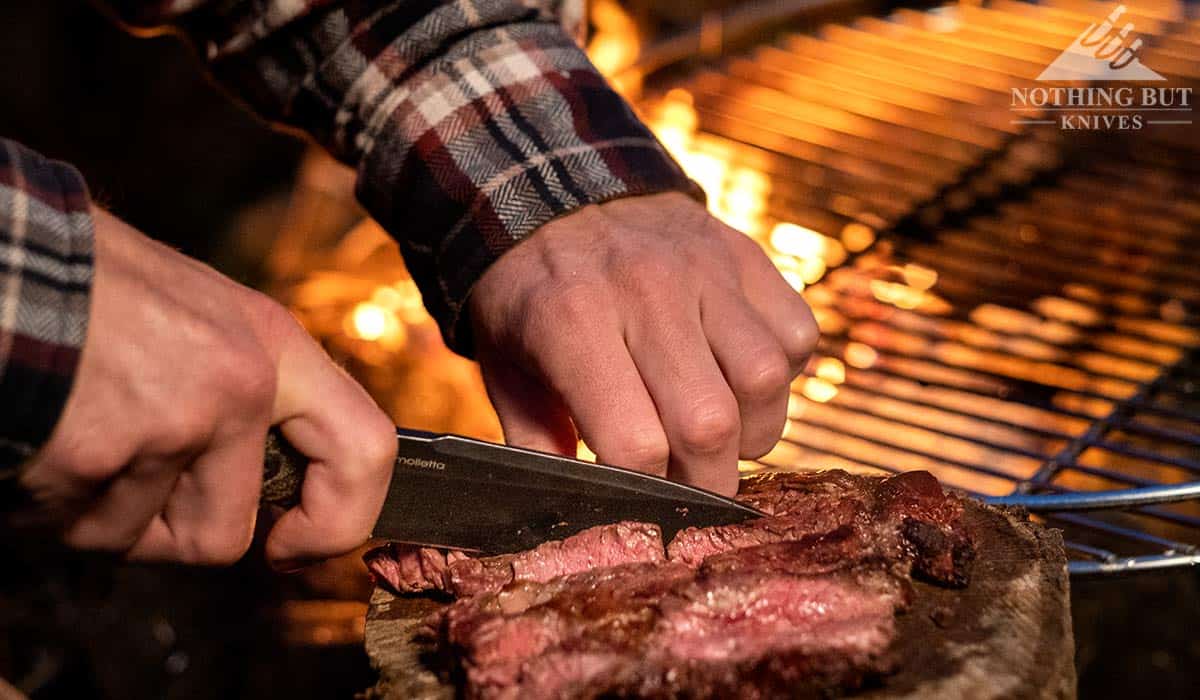
The thickness of the the blade and the blade guard combine to make the T5 less than ideal for food prep. However that is true of almost all bushcraft or survival knives.
In spite of its lack of similarities with a kitchen knife the T5 does a decent job as a camping food prep tool. It won’t slice effortlessly through a piece of meat the way a kitchen carving knife does, but a carving knife would not be able to chop the wood to make a campfire like the T5 can.

I often mention that I don’t get too opinionated on the tactical capabilities of a knife, because I don’t feel qualified. However, I believe I can say without reservation that the T5 is a great tactical knife, because many qualified people have offered positive reviews of the T5 as a tactical knife. In fact the designer, Molletta, received input from several military personnel before and during the design process of the T5.
I will say that the T5 sliced through four water bottles easier than expected with the factory grind. I swung way harder than necessary in the above photo, and I should have reshot the image with a much more sedated swing for the sake of accuracy, but we ran out of water bottles. (Editor’s Note: It was a massacre).
Alternatives
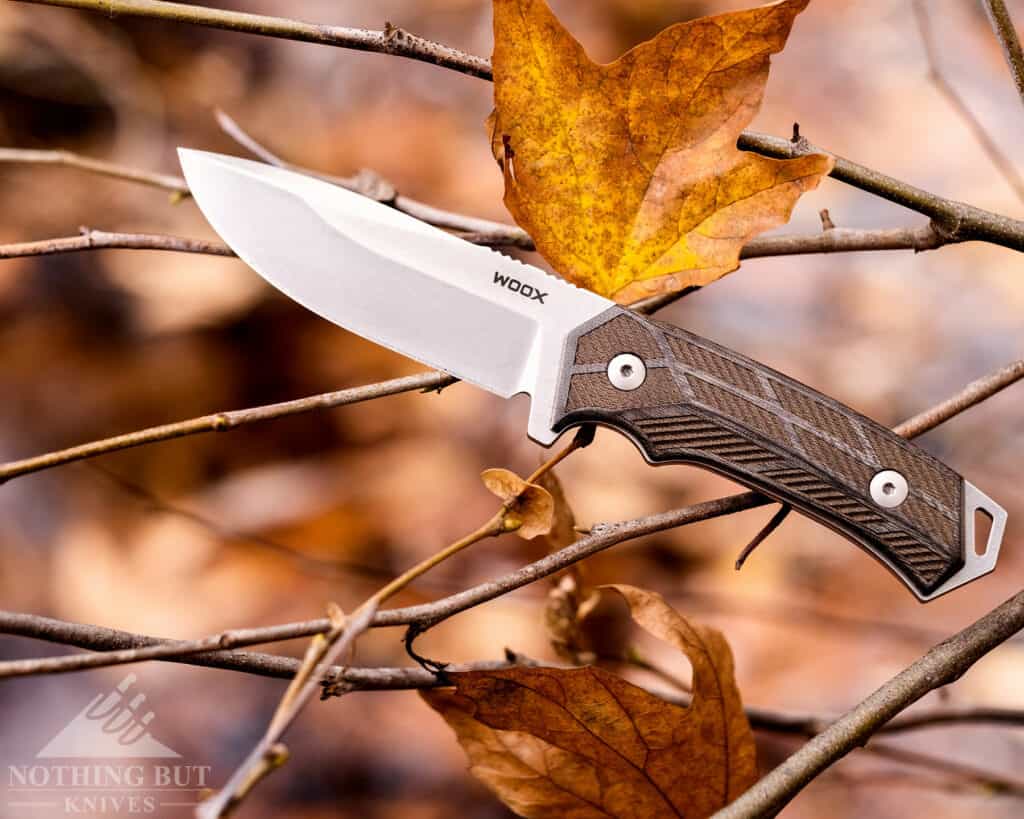
If you are looking for a great camping knife, the Buck Compadre is a decent option that costs a few bucks less than the LionSteel T5. However, if you are in the market for an all around great survival knife, the Woox Rock 62 is probably the best alternative to the T5. It is priced similarly, and there are a variety of of great handle options available. The Rock 62 arguably has better steel, but it ships with a sheath that is inferior to the LionSteel T5’s sheath. Fortunately Woox does offer a sheath upgrade for the Rock 62.
Te LionSteel M5 is the most obvious alternative. It is a little smaller and the handle is a bit more conventional.
The Demko FreeReign is another possible alternative to the T5. It is a little cheaper, and it has one of the most innovative sheaths I have ever used.
Should You Buy It?
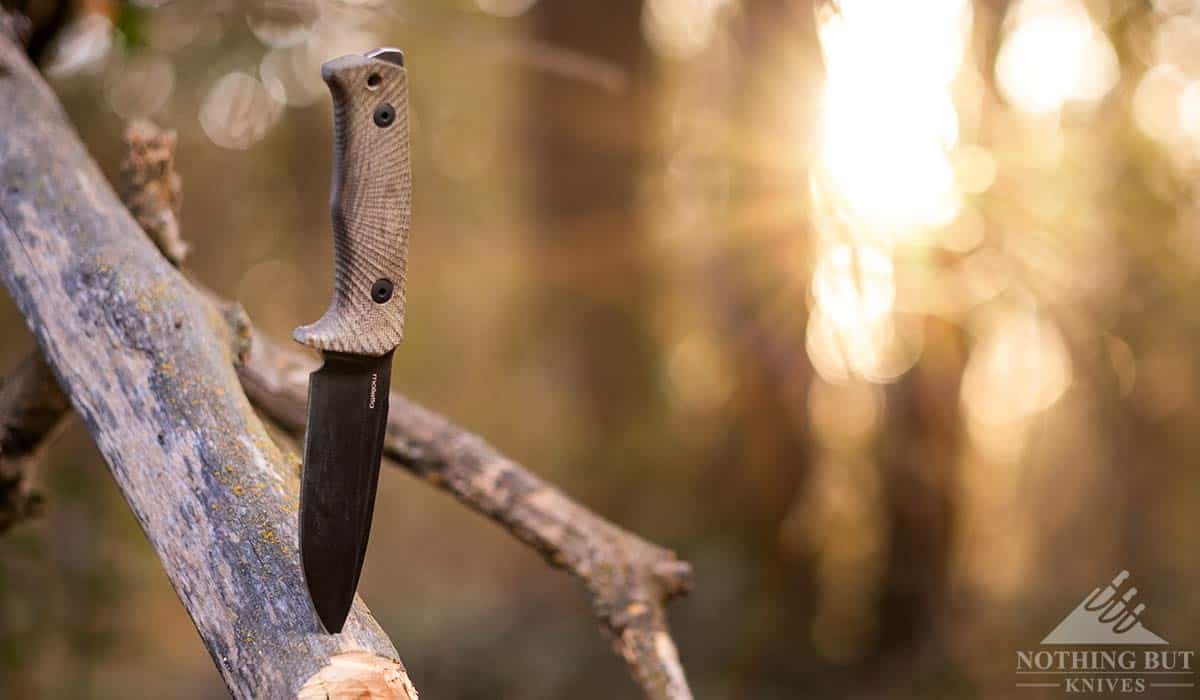
In spite of a few shortcomings, the lionSteel T5 stands out from the growing crowd of tactical/survival knife hybrids both for its overall aesthetic and its remarkable field performance.
While I was stoked with the versatility of the leather sheath, the great blade design, and the ergonomic handle made of a single piece of Micarta, it was the incredible balance of the knife that most impressed me. It’s just blade heavy enough to improve its overall performance at a variety of tasks, and it just feels really natural in the hand.
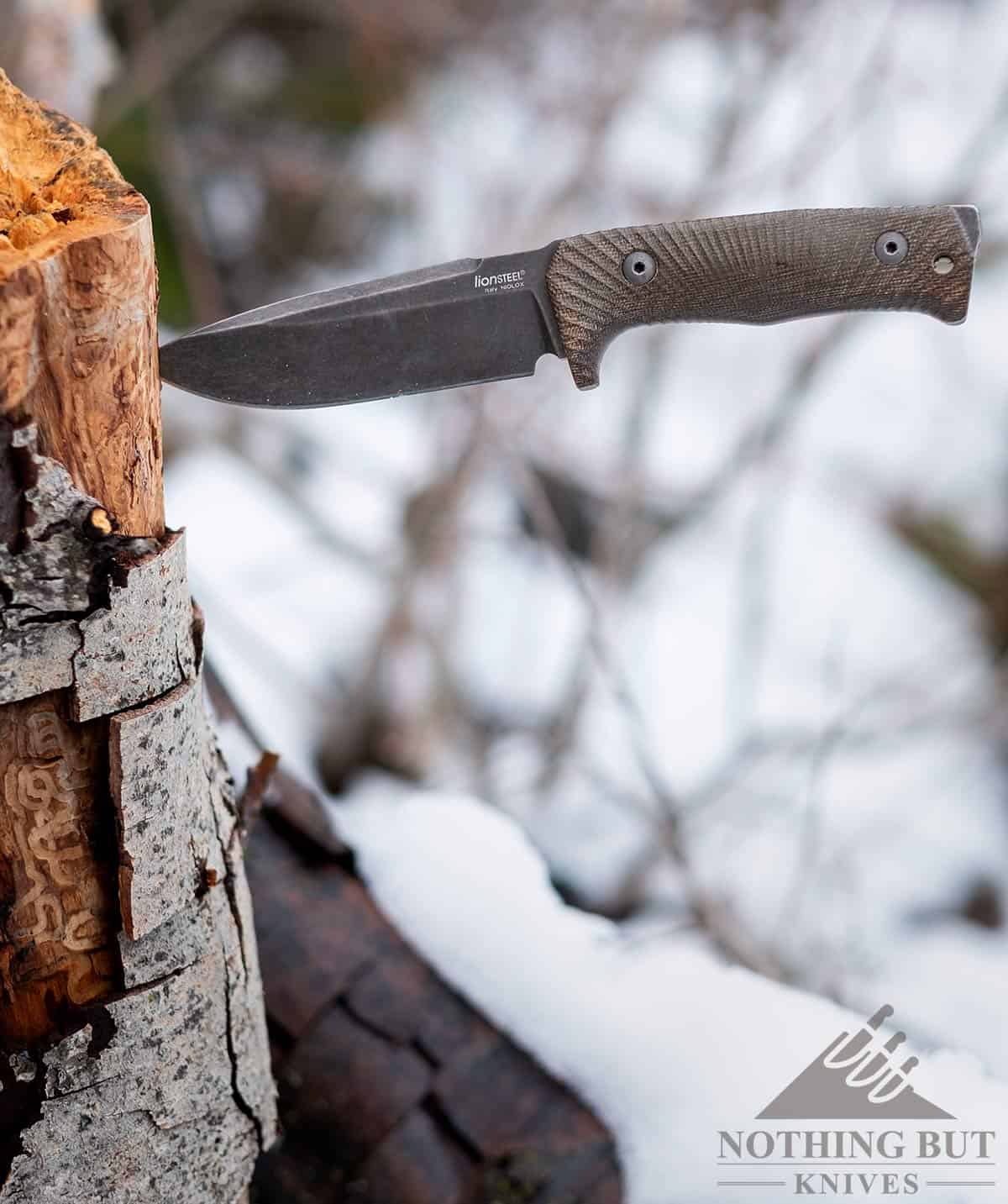
I do wish the butt plate didn’t cause a hot spot when chopping and I wish the lanyard hole went through the tang, but I would not want anything to change on this knife that would possibly affect its overall balance. In spite of its good looks it is the overall feel of the knife that sets it apart.
The T5 is not a cheap knife, but after months of testing and abuse I can say without reservation that I am not in any way suffering from buyer’s remorse. I do regret pushing it so hard in the batoning phase of testing, but that is a mistake we make regularly here at Nothing But Knives. If we drank less and made better decisions (and had fewer oak trees) we would have fewer scars and our knives would be in better condition, but our reviews would be even more unreadable.

I just bought a satin blade T5 with the black micarta handle from Amazon for $152.95 with prime shipping.I think that the T5 is a whole lot of knife for the money. i have a pair of XXL mitt’s for hand’s and i swear the grip feels like it was molded using my hand.Your review is pretty much spot on.I agree the balance of this knife is incredible.
Hi William. Stoked to hear you bought one. You are exactly right about the handle and the fact that it is a lot knife for the money. The T5 is just an all around good fixed blade. Thanks for your input. Much appreciated.
Hi Ben, did the coating suffered from all the test you conducted? Planning to get the T5 but currently torn between the finish. Thanks.
Hi Fernando. The coating has held up surprisingly well considering the amount of abuse it has suffered. There are some very slight wear marks in the coating from batoning oak, but overall the coating has survived. With enough hard use all coatings fail eventually, but LionSteel did a great job with the T5 coating.
Bonjour Ben,
Thanks a lot for this very usefull review that conviced me to buy this knife (satin version) i was staring at for few months. I’m very happy with it. Beautiful, tough and so well balanced. Whatever i asked him, he does it properly, and i ask a lot…
Best regards from France
Thanks Stephan. Glad the article was helpful. The T5 remains one of our favorite fixed blades for camping and backpacking.
Just recieved my T5 and was searching about the use of that sheath , stumbled upon you article and was informative . I will be going back to your website , very well done , and enjoy a cold one .
Thanks Chris. We appreciate you reading our articles and taking the time to comment.
Hey, Ben
Do you know the factory grind angle? I read somewhere that they estimated 40 degrees, but that seems a little steep to me. Thanks for the review!
Hi Jon. I wasn’t able to find the factory grind angle info online, so I used the sharpie method to dial it in. I believe it was in the neighborhood of 20°. Next time I sharpen it, I will add the angle info to the review.
The Lanyard hole complaint is kind of dumb. It’s a thick piece of micarta. You’d rip the lanyard cord and break your wrist before you could even slightly damage the lanyard hole. Doesn’t make sense to be honest.
I don’t know that it’s just about damaging the lanyard hole. It’s just one less fail safe than there could be. Wrapping a lanyard around your wrist generally means you’re doing something high impact. Doing a lot of chopping, for example, could potentially loosen up the scales, so not having the lanyard run through the tang runs a higher risk of the blade flying out of your hand.
Not that the T5 is falling apart anytime soon, but it’s kind of our job to pick out whatever possible issues we can find with a design.
Nice review, thank you!
Is it possible to carry this on belt horizontally with a tek lok or something similar or is it too large?
It ships with a leather sheath that is vertical carry only, but Armatus Carry Solutions makes a kydex T5 sheath that looks to be Tek-Lok compatible.
The T5 is a little big for horizontal carry for me, but I have talked to many folks who horizontal carry knives this size or bigger.
Would you consider the T5 too big for an everyday carry? I am an over the road trucker and steel hauler and I’m always needing a good knife for cutting straps and think this may be an overall good knife for that and self defense if needed.
I think that would depend on a person’s situation. For me the T5 works for EDC, because I work in the woods much of the time. The sheath sits low enough to be comfortable when you are sitting, so it should work for a truck driver. From a self-defense standpoint, one handed deployment is quick and easy which separates the T5 from a lot of its competitors.